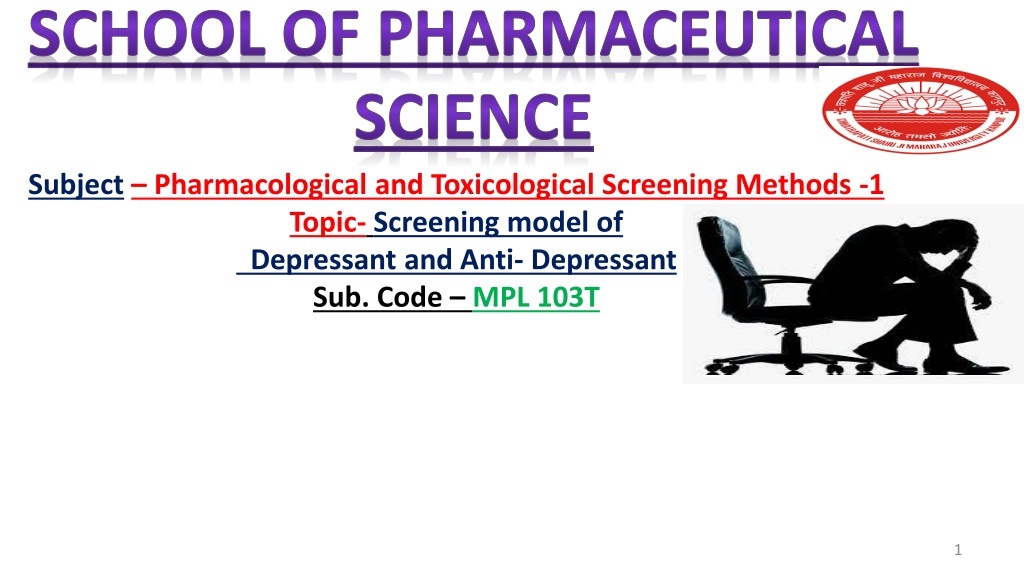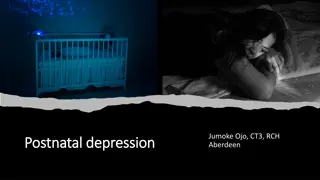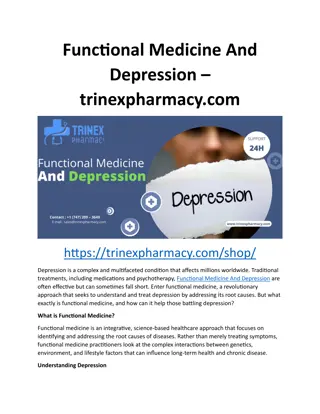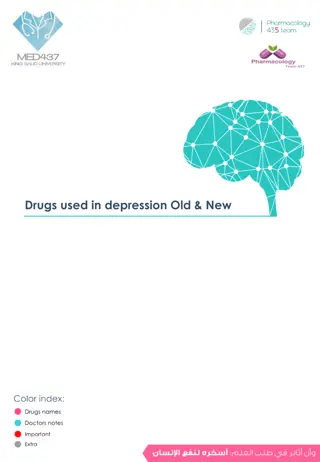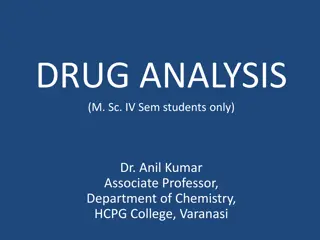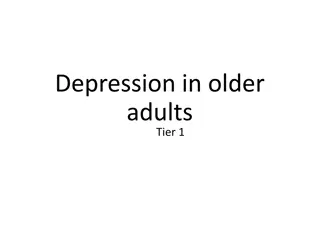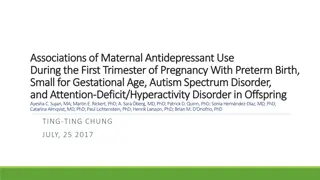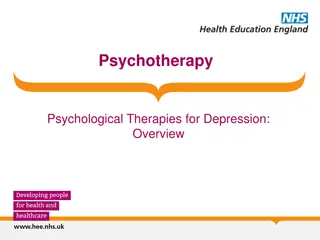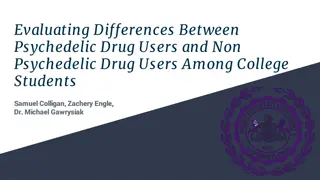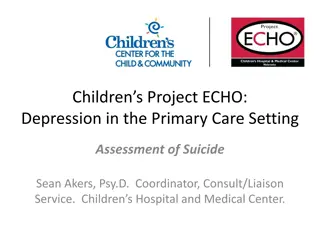Understanding Depression and Antidepressant Drug Classification
Depression is a severe mental disorder characterized by persistent low mood, affecting various aspects of a person's life. The causes of depression are diverse, including physical conditions, environmental factors, and genetic predisposition. Recognizing the symptoms is crucial for timely intervention. Antidepressant drugs are classified into typical and atypical categories based on their mechanisms of action, targeting neurotransmitters like serotonin and norepinephrine. Understanding these classifications is vital for developing effective treatment strategies for depression.
Download Presentation

Please find below an Image/Link to download the presentation.
The content on the website is provided AS IS for your information and personal use only. It may not be sold, licensed, or shared on other websites without obtaining consent from the author. Download presentation by click this link. If you encounter any issues during the download, it is possible that the publisher has removed the file from their server.
E N D
Presentation Transcript
SCHOOL OF PHARMACEUTICAL SCIENCE Subject Pharmacological and Toxicological Screening Methods -1 Topic- Screening model of Depressant and Anti- Depressant Sub. Code MPL 103T 1
Table of contents Introduction of depression Symptoms of depression Cause of depression Type of depression Anti- depressant screening models References @ BY SATENDRA CAHUHAN 2
What is depression ? Depression is a major affective disorder. It is a mental disorder in which the patient is characterized by pervasive and low mood with low self-neglect, feeling sad , unhappy, loss of interest , anorexia, sleep disturbance, and the patient may loss interest in daily activities. It is a chronic illness and potentially life threatening illness, which caused due to deficiency of three monoamine main neurotransmitter involved in depression are Dopamine, Noradrenaline, and serotonin(5HT) @ BY SATENDRA CAHUHAN 3
Symptoms of Depression Poor concentration Feeling of guilt Loss of motivation Loss of interest in activities. Loss of libido Thought of suicide Loss of appetite or excessive hungry Fatigue and decreased energy Weight gain or loss due to altered eating Insomnia , or increase sleep Worth lessens Decreased energy Sad mood Diminished interest in normal activities. @ BY SATENDRA CAHUHAN 4
Caused of Depression 5. Physical condition 6. Lack of consumption 7. Environmental factors 8. Academic stress 9. Socio cultural factors / Situation / Relationships 10. Alcohol consumption. 11. Other psychological disorders 1.Family history 2. Death or loss 3. Lack of Hormones 4. Trauma and stress @ BY SATENDRA CAHUHAN 5
Classification of drugs A)Typical antidepressant : (1) Reversible Inhibitor of MAO- A (RIMAs):-Moclobemide ,Clorgyline (2) Tricyclic Anti-depressant (TCAs) (a) NA + 5-HT reuptake inhibitors:- Imipramine , Amitriptyline, Trimipramine, Doxepin,Dothiepin ,Clomipramine (b) Predominantly NA reuptake inhibitor :- Desipramine , Nortriptyline , Reboxetine. (3 ) .Selective serotonin reuptake inhibitors (SSRIs) :- Fluoxetine , Fluvoxamine , Paroxetine, Sertraline, Citalopram ,Escitalopram Dapoxetine. (4). Serotonin and noradrenaline reuptake inhibitors (SNRIs) :- Venlafaxine , Desvenlafaxine ,Duloxetine (5) Atypical Anti-depressants :- Trazodone, Mianserin, Mirtazapine , Bupropion ,Amoxapione ,Tianeptine ,Amineptine 6 @ BY SATENDRA CAHUHAN
Type of Depression (1) Major depression:- in this type , the person feel depressed all time for most days of about two weeks or more. It is called as Major Depressive Disorder (MDD) It is related with loss of interest in normal activities and usual loneliness. Weight loss or gain, feeling insomnia or sleeping all the time , always have fatigue and low energy are some other symptoms. This is most common type of depression and can occur in any individual who have lost someone. It can be treated with psychotherapy and medication. @ BY SATENDRA CAHUHAN 7
(2).Persistent Depressive Disorder :- In this, the person is depressed for 2 years or longer and show all the signs and symptoms of depression. It is also called as Dysthymia. The person suffering this level feel low self-neglets , hopeless can not concentrate in anything, he either sleep too much or not at all. treatment can be done with the help of medication and psychotherapy or both. Bipolar disorder :-This is also called as Maniac - Depression because in this sometime the person feel mood swings of excitation and depression. @ BY SATENDRA CAHUHAN 8
Aims of Anti- depressant screening models Principle:- Major problems in search for new antidepressant drug are lack of animal models that resemble depressant treatment. Most of available screening models are based mainly an empirically established relationships between clinical efficacy of know antidepressants and their effects on various pharmacological test models. In combination with study of motor activity these tests allow assessment of specificity of anti- depressant activity by establishing ratio between Anti- depressants dose and stimulant or sedative dose. Same dose if ratio is close to. The test can find out how the potent the drugs it and the dose for anti-depressant activity because many drugs in higher or lower doses can give sedative or stimulatory action. @ BY SATENDRA CAHUHAN 9
Screening Models of antidepressant In vivo Methods :- Reserpine induced hypothermia. Water wheel model Tail suspensions test Forced Swim test . Muricidal behavior in rats Amphetamine potentiating test Apomorphine antagonism. In-vitro screening models:- Inhibition of NE uptake in rat brain Inhibition of dopamine uptake in rat striatal. @ BY SATENDRA CAHUHAN 10
(In vivo) 1.Reserpine induced Hypothermia :- Aim:- In this method depression is produce by inducing Reserpine. Animals required : Swiss albino mice (25-30) Chemicals required : Reserpine 2.5 mg/Kg s.c Procedure :- (1). The test measure ability of compound to inhibited Reserpine induced hypothermia in mice. (2).Used to screen potential antidepressants mice (male albino Swiss 25-30 gm ) 12 hr day-night cycle and free access to food and water. Reserpine in dose 2.5 5.0 mg/kg, s.c induces ptosis, hyperthermia, and catalepsy. @ BY SATENDRA CAHUHAN 11
(3). Reserpine given 2 hr before to test drug. (4). Rectal body temperature is measured every 30 min for 3 hr after drug injection. (5).Measure initial temperature. Conclusion :- By measuring of temperature, according to intensity of temperature, according to intensity of temperature anti depressant activity of test drug estimated @ BY SATENDRA CAHUHAN 12
(2).WATER WHEEL MODEL Aim:- This model is based on behavioral despair the anti- depressant activity of test drug by animals are allowed to forced swim. The animal is forced to swim without any escape in a water tank. Animal Albino mice (20-25 ) Chemical required Imipramine Equipment required Plexiglass water tank with wheel Temperature - 25o c. Route of administration : - i.p @ BY SATENDRA CAHUHAN 13
Water wheel Apparatus:- 14 @ BY SATENDRA CAHUHAN
PROCEDUR:- (1). The animals is forced to swim without any escape in water tank. (2) .A rotating wheel in water tank poses as an option for escape but adds on to the despair as it turns under the weight of animal and the animals has to keep rotating the wheel in order to stay afloat. (3). Keep its head above water. (4). The apparatus consist of a Plexiglass water tank ( 20 cm x 18 cm x 18 cm ) with in its centre. (5) .Water wheel is made of Plexiglass shat (diameter 3 cm, length 6 cm) on which 6 paddle ( o. 5 cm with ) move when loads of more than 5 gm are attached and number of rotation of water wheel are counted. @ BY SATENDRA CAHUHAN 15
(6) .Tank is filled up to height of 30 cm, 25o C. That paddles just touch the surface of water. (7). On discovering the water wheel, they climb onto it and begin turning it due to their weight. After a few minutes of attempted escape, they climb to wheel and just float in weight showing complete immobility. (8). For this method, mice ( 20- 25 ) randomly received control, standard and test group . 1st count number of rotations after that vehicle, Imipramine , test drug and rechallenged water wheel. Conclusion : - Potential antidepressant will increases the number of counts of water wheel turns, indicating increases effort at escape behavior . The classical tricycle antidepressant reduce immobility time in this model. But opiates and antihistaminic gives false positive results. @ BY SATENDRA CAHUHAN 16
(3). Tail Suspension test Aim : - This Model is a modification of behavior despair test. Animal in that situation alternates between 2 kinds of behavioral agitation (mobility) and immobility . When a rat is suspended by its by tail , the immobility is displayed because of inescapable stress. *The antidepressant drugs decrease the immobility in a tail suspended rat. *Water container Sex :- M/F Animal required :- Mice ( 25 30 gm) Equipment required : - Hanging wire @ BY SATENDRA CAHUHAN 17
Mobility and Immobility 1 3 2 @ BY SATENDRA CAHUHAN 18
Procedure (Tail suspension Tesr):- (1) Mice of either sex and wt (20 -30 ) are selected (2) Three group of are divided and proper food and water give. (3) Control , test ,and standard group are divided and give drugs via i.p route 30 min earlier when the test . (4) The rats are suspended upside down through its tail. ( 5) Hung on a wire mesh in an upside down posture such that is nostril touches the water surface in a container. (6) At the start of test , the rat try to escape but was to escape and become immobile after some time. @ BY SATENDRA CAHUHAN 19
*(7) . The reading were taken for 5 min time for activity and immobility was recorder and compared with and standard groups. Evaluation :- The duration of immobility of standard and test was compared with control groups and the decreased of immobility group. For different dose of drugs ED50 value was calculated. @ BY SATENDRA CAHUHAN 20
(4).Forced Swim Test Aim :- When rat or mice forced to swim in a restricted space from which they cannot escape are induced to a characteristic behavior of immobility. The ant depressant drug decrease the duration of immobility , it's most widely used method for screening of acute antidepressant. Animal required :- Rat or Mice @ BY SATENDRA CAHUHAN 21
Forced Swim test @ BY SATENDRA CAHUHAN 22
* Procedure(Forced Swim test) :- (1). Adult rats are allowed to swim in a cylinder with no escape filled with water at 25 0 C . (2).When the rats are forced to swim in water initially it was hyperactive but approx 5 min later the activity slow down and the phase of immobility starts. (3)After 15 minutes the rats were removed and allowed to dry. The duration of immobility was measured. (4).The same activity was done for standard and test groups and drug was administered 1 hour earlier when test start. Evaluation :- The duration of immobility was measured for test control and standard group treated with various drugs. The antidepressant drugs decrease the duration of immobility. @ BY SATENDRA CAHUHAN 23
(5). Isolation induced hyperactivity (In vivo Its is observed that rats when socially deprived for period of 15 days, exhibit depressive behavior. There is a reeducation is a reduction in spontaneous locomotors activity, behavior. There is a reduction in spontaneous locomotors activity, exploratory behavior rearing, and stereotypy. Adult Wistar rats of either sex (200-250gm) housed singly in cages (30 cm x 26 cm x 20 cm) any visual or auditory their normally housed counter parts for 10 15 days. Animals are subjected to behavior testing on an arbitrary scale for sleep, reduced response to external stimuli, ambulatory behavior, and stereotype posture. Both classical and newer antidepressant reduce isolation induced depressive behavior. @ BY SATENDRA CAHUHAN 24
In VITRO TEST. 1 ( Inhibition of Noradrenaline(NE) uptake in Rats brain :- Aim: - The reuptake of NE is an important physiological process. It is important for removing NE in synaptic cleft. Antidepressant inhibits the reuptake of NE. Hypothalamus is used for this as it has shown great uptake on NE. @ BY SATENDRA CAHUHAN 25
(1). Male Wistar rats were taken in groups. (2). They were decapitated and their brain are removed rapidly. (3). The hypothalamus is weight and it's preparation is made. (4). Homogenisation of this is done bye using ice cold sucrose solution 0.32 volumes with the help of POTTER ELVEJHEM homogenizer. (5). Centrifugation is done at 1000g at0.4 0 c for 10 min and supernatants is decanted which is used for . @ BY SATENDRA CAHUHAN 26
Inhibition of NE uptake in rat brain Assay:- 800mul 62.5Nm NE and 200mul of tissue suspension were mixed and incubated in KREBS- HENSELETT BICARBONATE BUFFER temperature 37 o c with 20mul test or standard drugs or vehicle in control. Incubation of each assay tube is done at 0 0 c ice bath with 20mul vehicle at 95 % o2 and 5 % CO2. Centrifugation is done for 10 min at 4000g. After that firstly the supernatant is aspirated and then pellets were dissolved in solubilizer. This was shaken and the decanted into scintillation vials This was counted in 10 ml liquid scintillation counting cocktail. The difference b/w cmp at 37 0 c and 0 o c is the active uptake . Evaluation:- The mean of at least three determination is calculated and this percent inhibition at each drug concentration. From log prohibit analysis IC50 values can be determined. Desipramine is a standard drug with IC50 values of 20nM. @ BY SATENDRA CAHUHAN 27
REFERENCE Handbook of experimental pharmacology S . K Kulkarni. Gupta, S .K Drug Screening Methods ( Preclinical Evaluation of Drugs ) Jaypee Brother Medical Publishers Pvt Ltd,2009 page-382-385. Tripathi. K.D., Essentials of medical pharmacology Jaypee publication,2006(7): 235-236. Association , American psychiatric . American Psychiatric Association Practice Guideline for the treatment of Psychiatric Disorder :Compendium 2006 . @ BY SATENDRA CAHUHAN 28
Release of NE @ BY SATENDRA CAHUHAN 29
Synthesis of 5-HT @ BY SATENDRA CAHUHAN 30
